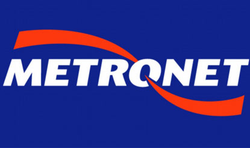- Metronet
-
Metronet Rail Ltd 
Type Private / consortium Industry Railway infrastructure Fate In administration 2007, dissolved 2009 Founded 2003 Headquarters Templar House, 81-87 High Holborn, London, WC1V 6NU Key people Andrew Cooper (BCV MD), David Crawley (SSL MD), Andrew Lezala (group CEO) Employees approx. 6000 Website www.metronetrail.com Metronet Rail was one of two companies (the other being Tube Lines Ltd) in a public-private partnership with London Underground.
Metronet was responsible for the maintenance, renewal, and upgrade of the infrastructure on nine London Underground lines from 2003 to 2008. This included track, trains, signals, civil work and stations. From 18 July 2007 to 26 May 2008, the company was in administration and had to be bailed out by the government. On 27 May 2008, the company responsibilities were transferred back into public ownership under the authority of Transport for London.[1] In June 2009 the National Audit Office estimated that the failure of the Metronet PPP contract cost the taxpayer up to £410m adding that "most of the blame for Metronet's collapse lay with the consortium itself."[2] The administration complete, the joint administrators petitioned the High Court of Justice for the winding-up of the company on the 3 November 2009, the petition to be heard on the 10 December 2009.[3]
Before Metronet Rail entered PPP Administration, it had five shareholders:
- Atkins,
- Balfour Beatty,
- Bombardier,
- EDF Energy, and
- Thames Water.
The Metronet Rail brand consisted of separate trading companies, Metronet Rail BCV Ltd and Metronet Rail SSL Ltd : 'BCV' standing for Bakerloo,Central & Victoria lines and 'SSL' for Sub-surface Lines (Circle, District, East London, Hammersmith+City & Metropolitan). Following administration these were transferred temporarily to new companies named LUL Nominee BCV Ltd and LUL Nominee SSL Ltd.
From April 2003 to May 2008, London Underground was operated as a Public-Private Partnership (PPP), where the infrastructure and support services were maintained by private companies but the London Underground was still publicly owned and operated by Transport for London (TfL). Metronet Rail had been the successful bidder for the two 30-year contracts for the following tube and sub-surface lines:
BCV (tube) lines contract
SSL (sub-surface) lines contract
Under the terms of the contracts, Metronet Rail agreed to provide London Underground (LU) with trains, stations, and related infrastructure to the standards and performance levels required to give the travelling public a reliable service in a safe, efficient, and economic manner. LU paid the Metronet Rail consortium an infrastructure service charge (ISC) - a monthly payment increased or abated to reflect the network's performance. Revenue to the consortium was reduced if service fell below benchmark levels and deductions suffered for poor performance were at twice the rate of the increase in revenue for improved performance.
Metronet Rail had contracted to modernise and refurbish 150 stations by 2012, with £17 billion invested over the course of the 30-year contract. Within their maintenance and capital-project management remit they had 347 trains, over 471 miles (758 km) of track, 155 stations, 77 miles (124 km) of deep tubes, and over 2000 points, crossings, and bridges.
In November 2006, Metronet were heavily criticised by the PPP arbiter, Chris Bolt, over their performance from 2003 to 2006. His analysis included criticism that Metronet had not performed in an economic or efficient manner, and had failed to follow good industry practice.[4]
The remaining London Underground lines, (Jubilee, Northern and Piccadilly) remained under a PPP arrangement with Tube Lines until May 2010 when it was announced that Transport for London would buy out the Tube Lines consortium.[5]
Financial crisis
On 17 July 2007 it was reported[6] that Metronet was "teetering on the brink of administration". The situation arose because it had received only £121m out of the £551m it needed to cover cost over-runs. By contrast, Tube Lines, the other PPP company, had brought in almost all of its works on time and on budget.[7]
On 18 July 2007, an administration order was made.[8] The Court appointed Ernst & Young LLP in the persons of Alan Robert Bloom, Roy Bailey, Margaret Elizabeth Mills and Stephen John Harris as special PPP administrators.[3] To enable the business activities to be kept going it was subsequently bailed out by the UK Government at a cost of £2 billion.[9] On 27 May 2008, Metronet came out of administration and the contracts and employees transferred to Transport for London under two new temporary companies, LUL Nominee BCV Ltd and LUL Nominee SSL Ltd.
On 3 December 2009, the PPP business of former Metronet Rail became an integral part of London Underground.
In 2010 the House of Commons' Public Accounts Committee reprimanded the Department for Transport for its failure to heed National Audit Office warnings about the company's management.[10]
By the beginning of 2011 with the formal liquidation process having been completed, the Metronet brand and group of companies had ceased to exist.
References
- ^ "Metronet Rail transfers to TfL control". TfL. 27 May 2008. http://www.tfl.gov.uk/static/corporate/media/newscentre/archive/8376.html.
- ^ "Metronet failure cost taxpayer upto £410m". Contract Journal. Archived from the original on 2009-06-15. http://replay.web.archive.org/20090615204123/http://www.contractjournal.com/Articles/2009/06/05/68403/metronet-failure-cost-taxpayer-upto-410m.html.
- ^ a b The London Gazette, 11 November 2009, pp. 19523
- ^ "Tube and train services disrupted". BBC News. 20 November 2006. http://news.bbc.co.uk/1/hi/england/london/6164580.stm. Retrieved 12 January 2007.
- ^ "Tube maintenance back 'in house' as new deal is signed". BBC. 8 May 2010. http://news.bbc.co.uk/1/hi/england/london/8669823.stm. Retrieved 2010-05-09.
- ^ Hawkes, Steve (17 July 2007). "Metronet on brink of collapse after plea on costs is rejected". The Times (London). http://business.timesonline.co.uk/tol/business/industry_sectors/support_services/article2087535.ece.
- ^ Partnership that turned sour, The Times, 27 June 2007
- ^ "Metronet calls in administrators". BBC. 18 July 2007. http://news.bbc.co.uk/1/hi/business/6903977.stm. Retrieved 2007-08-21.
- ^ "Govt in £2bn Metronet bail-out". http://www.inthenews.co.uk/news/transport/govt-in-2bn-metronet-bail-out-$1197787.htm.
- ^ DoT failed to heed NAO warning over Metronet finances, Accountancy Age, 2 March 2010
External links
Categories:
Wikimedia Foundation. 2010.
